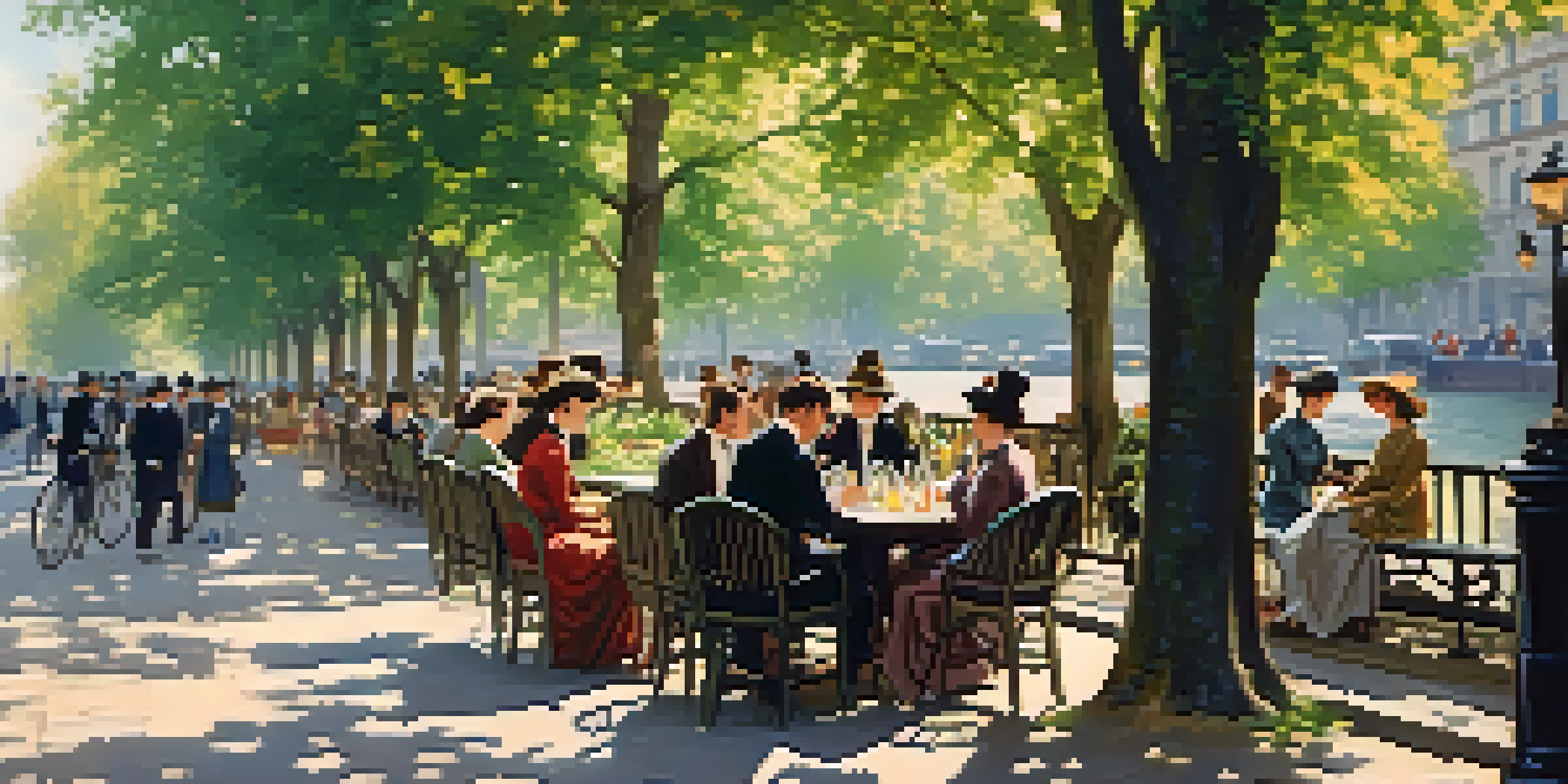How Impressionism Reflects Cultural Changes in 19th Century

The Birth of Impressionism and Its Context
Impressionism emerged in the late 19th century as a response to traditional academic painting. Artists sought to capture the fleeting moments of everyday life, moving away from historical and religious themes that dominated earlier art. This shift reflected a broader cultural change, as society began to embrace modernity and the experience of the individual. The term 'Impressionism' itself was derived from a painting by Claude Monet, emphasizing the artists' focus on light and atmosphere, rather than meticulous detail.
The painter's only guide is his own eye, and the only thing that counts is the impression he receives from nature.
In this period, the Industrial Revolution was reshaping cities and lifestyles, leading to new experiences and environments for artists. Urbanization brought about a dynamic change in how people lived and interacted, and Impressionists sought to depict these transformations. The rise of cafes, parks, and bustling streets became popular subjects, mirroring the excitement and chaos of contemporary life.
Moreover, Impressionism coincided with significant social changes, including shifts in gender roles and class structures. Women began to participate more actively in the arts, both as subjects and creators, which was revolutionary for the time. This cultural evolution was vividly portrayed in Impressionist works, as artists captured the essence of modern life with a fresh perspective.
Revolutionizing Artistic Techniques and Perspectives
Impressionist artists broke away from traditional techniques, utilizing new methods to convey their vision. They often painted en plein air, or outdoors, which allowed them to capture the natural effects of light and color. This approach was revolutionary, as it encouraged artists to focus on the immediate experience of a scene rather than relying on detailed sketches made in a studio.

The use of loose brush strokes and vivid colors became hallmarks of Impressionism, distinguishing it from the more rigid styles of the past. This technique was not merely aesthetic; it reflected a new way of seeing the world, one that appreciated spontaneity and movement. By embracing these innovative methods, Impressionists invited viewers to engage with their art in a more personal and emotional way.
Impressionism's Cultural Shift
Impressionism emerged as a response to modernity, focusing on everyday life and social changes during the late 19th century.
Additionally, the perspective chosen by Impressionist artists often featured unconventional compositions. They would crop images in ways that mimicked the spontaneity of a snapshot, creating a sense of immediacy. This shift in perspective not only changed the way art was created but also how it was perceived, contributing to the cultural landscape of the time.
The Influence of Photography on Impressionism
The advent of photography in the 19th century significantly influenced the development of Impressionism. As photographers captured moments in time with precision, painters began to explore how they could convey a sense of movement and emotion that photography could not. This creative tension led to a revolutionary approach in artistry, emphasizing interpretation over replication.
Art is not what you see, but what you make others see.
Impressionist painters often sought to depict the world in a way that felt more alive and vibrant than a photograph could. They focused on capturing the essence of a scene rather than its exact details, allowing for a more subjective experience. This shift was emblematic of a culture moving towards embracing personal expression and emotional depth.
Moreover, the relationship between photography and Impressionism underscored a broader cultural shift towards modernity. As society began to value the individual experience, artists reflected this sentiment in their works, showcasing the beauty of everyday life. The juxtaposition of photography and painting ultimately enriched both mediums, pushing artists to innovate and redefine their craft.
Social Commentary in Impressionist Art
While Impressionism is often celebrated for its beauty and light, it also served as a social commentary on the changing world. Many Impressionist works depicted the lives of ordinary people, highlighting the effects of industrialization and urbanization. By focusing on subjects that were often overlooked, these artists brought attention to the evolving social landscape of the 19th century.
For instance, paintings featuring leisure activities in city parks or bustling marketplaces reflected a new social dynamic. The increasing visibility of the working class and the bourgeoisie in art signified a shift in societal values. Impressionists challenged the established norms, showing that the lives of everyday people were worthy of artistic exploration.
Women Artists' Impact
Female artists like Berthe Morisot and Mary Cassatt challenged gender norms and contributed unique perspectives to the Impressionist movement.
This focus on social themes resonated with viewers, making Impressionism not only an art movement but also a reflection of contemporary issues. The ability of these artists to capture the spirit of their time placed them at the forefront of cultural discourse, engaging audiences in conversations about class, identity, and modern life.
Women in Impressionism: Breaking Boundaries
The role of women in the Impressionist movement marked a significant cultural shift during the 19th century. Female artists began to gain recognition and respect in a field that had been dominated by men. Pioneers like Berthe Morisot and Mary Cassatt not only contributed to the movement but also challenged traditional gender roles through their work and presence in the art community.
These women brought unique perspectives to their art, often focusing on themes of domestic life and the inner experiences of women. Their works provided insights into the everyday lives of women, showcasing intimacy and emotion in ways that were rarely seen before. This focus not only enriched the Impressionist movement but also opened doors for future generations of female artists.
Moreover, the representation of women in Impressionist art reflected changing societal attitudes towards gender. By highlighting women's experiences and roles, these artists contributed to a broader conversation about women's rights and empowerment. The legacy of these women in Impressionism continues to inspire discussions about gender equality in the arts today.
Impressionism's Global Influence and Legacy
Impressionism's impact extended far beyond France, influencing artists around the globe. As the movement gained momentum, it inspired other styles and movements, including Post-Impressionism and even modern art. This cross-pollination of ideas illustrated a cultural exchange that reflected the interconnectedness of the 19th century world.
Artists in various countries began to adopt and adapt Impressionist techniques, creating their own regional interpretations. For example, in America, artists like Childe Hassam embraced the style while infusing it with local themes and landscapes. This global reach showcased how Impressionism resonated with diverse cultures, reflecting shared human experiences.
Global Influence of Impressionism
The movement inspired artists worldwide, leading to diverse interpretations and a lasting legacy that continues to shape contemporary art.
The legacy of Impressionism continues to be felt in contemporary art, as artists strive to capture the ephemeral nature of life. Its emphasis on personal expression and the beauty of the everyday remains relevant, encouraging new generations to explore their creativity. Ultimately, Impressionism not only transformed the art world but left an indelible mark on culture as a whole.
Conclusion: Impressionism as a Cultural Mirror
In conclusion, Impressionism serves as a powerful reflection of the cultural changes occurring in the 19th century. Through its innovative techniques and focus on modern life, the movement encapsulated the spirit of an era marked by transformation and upheaval. Artists captured the essence of their time, connecting with viewers on a personal and emotional level.
The movement's embrace of individuality and exploration of social themes highlighted the shifting values in society, providing a platform for voices that had long been marginalized. By celebrating everyday moments and the beauty of the ordinary, Impressionists not only redefined art but also offered a lens through which to understand the complexities of their world.

As we reflect on the impact of Impressionism today, we recognize its enduring legacy in influencing both art and culture. The movement's ability to adapt and resonate with future generations underscores the importance of art as a mirror to society, encouraging us to continue exploring and questioning our own cultural narratives.